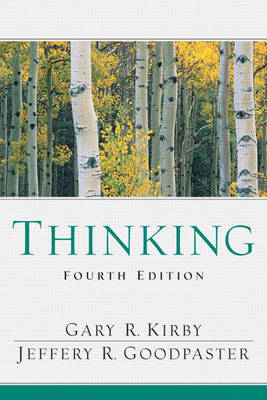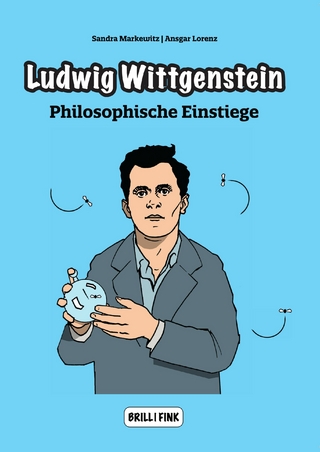
Thinking
Pearson (Verlag)
978-0-13-220974-8 (ISBN)
- Titel ist leider vergriffen;
keine Neuauflage - Artikel merken
Thinking's comprehensive and interdisciplinary approach encourages a more complete and practical treatment for the student of how to think logically, critically, creatively, and persuasively.
The authors wrote this book to give teachers and students a friendlier, more comprehensive, more systematic, more interdisciplinary, and thus a more effective text than any on the market.
1 What Is Thinking?
OUR CULTURAL LEGACY
WHY THINK?
THINKING ACTIVITY 1.1: Things More Important Than Thinking
Thoughts Richer Than Gold
Thinking as Possibility
Thoughts Accumulate
Life Without Thinking
WHAT IS THINKING?
The Mystery
Toward a Definition: Thinking as Communicating
BOX: The Centrality of Thinking
COMMUNICATING: THE MIRROR OF THOUGHT
Thinking as Writing: Clarity, Exactness, Awareness, Richness
THINKING ACTIVITY 1.2: Thinking, Sensing, Writing
Thinking as Dialogue: Validation and Insight
MISTHINKING
SUMMARY
THINKING CHALLENGES
2 Personal Barriers
ENCULTURATION
Sources of Enculturation
BOX: Some Common American Beliefs
Religion and Enculturation
BOX: Spinoza: A Man of Reason
THINKING ACTIVITY 2.1: Our Own Enculturation
SELF-CONCEPT
THINKING ACTIVITY 2.2: The Idea of Self
THINKING ACTIVITY 2.3: Letting Go
EGO DEFENSES
Denial
Projection
Rationalization
SELF-SERVING BIASES
BOX: Other Attribution Errors
BOX: Self-Serving Biases?
THINKING ACTIVITY 2.4: Owning Up to Our Dark Side
THE ROLE OF EXPECTATIONS AND SCHEMATA
EMOTIONAL INFLUENCES
Anger
Passion
Depression
THINKING ACTIVITY 2.5: Five Thinking Errors
STRIVING FOR COGNITIVE CONSISTENCY
STRESS
BOX: Signs and Symptoms of Stress
Stress Management
THINKING ACTIVITY 2.6: Five Ways to Prevent Stress
SUMMARY
BARRIER CHALLENGES
3 Sensing
SENSUAL BEGINNINGS
THE POWER OF OUR SENSES
THE DECEPTION OF OUR SENSES
THINKING ACTIVITY 3.1: Ideas: Innate or Learned?
THINKING ACTIVITY 3.2: Our Personal Sense Deceptions
SHARPENING OUR SENSES
THINKING ACTIVITY 3.3: Seeing Anew
POWERFUL LISTENING
The Paradox of Powerful Listening
How to Listen
THINKING ACTIVITY 3.4: Developing an Action Plan
SUMMARY
SENSING AND THINKING CHALLENGES
4 Brain and Memory
THE MYSTERY
THINKING AND OUR BRAIN
THINKING ACTIVITY 4.1: An Exercise in Mental Discipline
Food and Drugs
Sleep
THINKING ACTIVITY 4.2: Critical Reading Before We Sleep
Our Thinking Potential
BOX: Brain and Mind
THINKING AND MEMORY
The Changing Nature of Memory
THINKING ACTIVITY 4.3: Memories of Childhood
Forgetting
BOX: Recall versus Recognition
Why We Forget
How to Improve Memory
THINKING ACTIVITY 4.4: Using Mnemonics
BOX: Memory Pills
SUMMARY
BRAIN AND MEMORY CHALLENGES
5 Language: Our Thinking Medium
THINKING ACTIVITY 5.1: Language and Thinking
LANGUAGE AND OUR MIND
The Universalizing Power of Language
The Structuring Power of Language
LANGUAGE AND SOCIETY
THINKING ACTIVITY 5.2: A Brief Mind Sketch
THE METAPHORICAL POWER OF LANGUAGE
What Is a Metaphor?
Metaphorical Models Control Thinking
BOX: Language, Lawyers, and Lawmakers
THE LIMITATIONS OF LANGUAGE
THE POWER OF ENGLISH
Word Meanings
THINKING ACTIVITY 5.3: The Language in Our Mind
THINKING ACTIVITY 5.4: Identifying Our Flame Words
Word Order Creates Meaning
The Power Parts: Noun and Verb
Thinking and the Context
Clarity
BOX: Clearly Embarrassing
THE PITFALLS OF ENGLISH
Generalizations and Abstractions
BOX: High Specificity
Wordiness
Redundancies
Illogicalities
Clichés
SUMMARY
LANGUAGE CHALLENGES
6 Feeling
FEELINGS AND THINKING
CULTURAL CONTEXT
Business
Church
Family
THE FORCE BEHIND OUR THOUGHTS
Beneath the Rational Surface
The Importance of Tone
THINKING ACTIVITY 6.1: Feelings Beneath Our Thoughts
CONTROLLING EMOTIONS
GENERATING SPEECH
GENERATING WRITING
The Inspiration Method
The Recollection Method
The Conscious Selection Method
FEELINGS TOWARD TOPIC AND AUDIENCE
THINKING ACTIVITY 6.2: Evoking Emotions
OBSERVING FEELINGS
SUMMARY
THINKING AND FEELING CHALLENGES
7 Creative Thinking
WHAT IS CREATIVITY?
METAPHORICAL THINKING
THINKING ACTIVITY 7.1: Making Metaphors
KINDS OF CREATIVE THINKING
WHO CAN THINK CREATIVELY?
THINKING ACTIVITY 7.2: Poetic Impressions
CONDITIONS AND LIMITATIONS OF CREATIVITY
BEGINNING TO CREATE
Brainstorming
Starbursting
COAXING CREATIVITY
Step 1: Desire
Step 2: Knowledge and Skills
Step 3: Edisonian Effort
THINKING ACTIVITY 7.3: Prepcreation
Step 4: Fermentation and Insight
Step 5: Evaluation
SUMMARY
BOX: Leonardo da Vinci
CREATING CHALLENGES
8 Organizing
ORIGINS OF ORDER
NATURAL/MENTAL ORDERS
Topical Order
Analogical Order
Chronological Order
Causal Order
THINKING ACTIVITY 8.1: Other Natural Orders?
THINKING ACTIVITY 8.2: The Order of the Elements
MENTAL ORDERS
THINKING ACTIVITY 8.3: Other Mental Orders
Clarity and Memory
STEPS IN ORGANIZING
1. Clustering
2. Analyzing
THINKING ACTIVITY 8.4: Analyzing the Clusters
3. Prioritizing
4. Organizing Your Space
5. Organizing Electronic Data
USING THE ORDERS
THINKING ACTIVITY 8.5: Creating a Seminal Structural Analogy
Curtain Call
SUMMARY
ORGANIZING CHALLENGES
9 Logical Thinking
DEDUCTIVE THINKING: THE SYLLOGISM
CATEGORICAL SYLLOGISMS
Three Kinds of Propositions
Four Figures
THINKING ACTIVITY 9.1: Drawing the Conclusion
THINKING ACTIVITY 9.2: Finding Terms and Figures
Validity of Categorical Syllogisms
THINKING ACTIVITY 9.3: Identifying Valid Categorical Syllogisms
THINKING ACTIVITY 9.4: Using Venn Diagrams
ENTHYMEMES AND SYLLOGISMS IN EVERYDAY LIFE
Sorites
THINKING ACTIVITY 9.5: Finding Multiple Syllogisms and False Premises
REASONING ERRORS IN CATEGORICAL SYLLOGISMS
Undistributed Middle
Illicit Process
THINKING ACTIVITY 9.6: Finding Undistributed Terms
The Four-Terms Fallacy
Equivocation
Existential Fallacy
BOX: The Importance of Agreed Meaning
RULES FOR THE CATEGORICAL SYLLOGISM
THINKING ACTIVITY 9.7: Identifying Invalid Syllogisms
HYPOTHETICAL SYLLOGISMS
Reasoning Errors in Hypothetical Syllogisms
DISJUNCTIVE SYLLOGISMS
Reasoning Error in the Disjunctive Syllogism
VALID CONVERSIONS
THINKING ACTIVITY 9.8: Writing Valid Conversions
INFORMAL DEDUCTIVE FALLACIES
The Fallacy of Division
Circular Reasoning
The Either/Or Fallacy
THINKING ACTIVITY 9.9: Identifying the Either/Or Fallacy
BOX: Reductio ad Absurdum
INDUCTIVE THINKING
THINKING ACTIVITY 9.10: Distinguishing Between Inductive
and Deductive Arguments
THINKING ACTIVITY 9.11: Considering Past Errors
ANALOGICAL ARGUMENT
BOX: Chuang Tzu’s Analogies
THINKING ACTIVITY 9.12: Using Analogies
CAUSATION
THINKING ACTIVITY 9.13: Thinking About Causation
INFORMAL INDUCTIVE FALLACIES
Hasty Generalization
The Fallacy of Composition
Post Hoc Ergo Propter Hoc
Extravagant Hypothesis
BOX: Conspiracy Theories
False Analogy
Slippery Slope
OTHER REASONING FALLACIES
The Genetic Fallacy
Appeal to Authority
Appeal to Tradition
The Is/Ought Fallacy
BOX: More Thoughts About Oughts
Bandwagon Appeal
Appeal to Ignorance
SUMMARY
LOGIC CHALLENGES
10 Scientific Thinking
THE SCIENTIFIC METHOD
Observation
Hypothesis
Experimentation
Verification
Science and Other Ways of Knowing
BOX: Copernicus and Galileo
THE EMPIRICAL NATURE OF SCIENCE
Erroneous Operational Definitions
Operational Debates
The Limits of Science
THINKING ACTIVITY 10.1: Creating Operational Definitions
THINKING ACTIVITY 10.2: The Domain of Science
SCIENCE AND THE UNDERSTANDING OF HUMAN NATURE
Determinism as Foundation
Human Beings and Determinism
BOX: Determinism and Probability
PROVING A THEORY
CONTROLLED EXPERIMENTS
QUASI EXPERIMENTAL DESIGN
NONEXPERIMENTAL DESIGNS
Ex Post Facto
Correlational Design
THINKING ACTIVITY 10.3: Determining the Research Design
The Survey
BOX: Opinion versus Fact
Case Studies
The Rule of Chance
BOX: Sizeable Effects
BOX: Gambler’s Fallacy
EXPERIMENTER BIAS
BOX: The Placebo Effect
BOX: Cases of Fraud
Pseudoscience
SUMMARY
SCIENTIFIC THINKING CHALLENGES
11 Persuasive Thinking
WHAT IS PERSUASION?
THE ETHICS OF PERSUASION
THINKING ABOUT WHAT MOVES US
Knowledge
Objectivity and Honesty
BOX: Confucius, Christ, and Kant
Biases
Likability
Motivation and Purpose
The Rational Appeal
The Emotional Appeal: The Root Elements
THINKING ABOUT WHAT MOVES OUR AUDIENCE
Demographics
THINKING ACTIVITY 11.1: A Demographic Analysis
Values and Needs
THINKING ACTIVITY 11.2: Identifying Values and Needs
Adjusting Our Goals
THINKING ACTIVITY 11.3: Motivation Mountain
ORGANIZING FOR PERSUASION
Step 1: Establishing Credibility
Step 2: Acknowledging the Audience’s Position
Step 3: Constructing Our Rationale
THINKING ACTIVITY 11.4: Recognizing the Other Side
Step 4: Transplanting the Root Elements
Step 5: Asking for the Response
DEFENDING OURSELVES AGAINST DECEITFUL PERSUASION
Manipulative Tactics
THINKING ACTIVITY 11.5: Your Vulnerability to Fear Appeals
Erroneous Attacks
Abuse of Language
SUMMARY
PERSUASION CHALLENGES
12 Problem Solving
DEFINING THE PROBLEM
Thinking Activity 12.1: Forming More Precise Definitions
Discovering Causes
Problems Without a Cause
REMOVING BARRIERS
The Myth of Perfection
The Myth of Genius
GENERATING SOLUTIONS
Gathering Information
THINKING ACTIVITY 12.2: Identifying Problem Components
BOX: Creating a Healthy Communication Climate
Creative Thinking
Let it Rest
THINKING ACTIVITY 12.3: Functional Fixedness
SELECTING SOLUTIONS
Preliminary Evaluation
BOX: Chaotic Systems
Pros and Cons
BOX: Rejections on Minor Grounds
THINKING ACTIVITY 12.4: Weighing Pros and Cons
Subgoal Analysis
Trial and Error
Working Backwards
BOX: Thinking Backwards
Problem-Solving Tips
EVALUATING SOLUTIONS
SUMMARY
PROBLEM-SOLVING CHALLENGES
13 Evaluating
THE NECESSITY TO TEST THINKING
The Crucible of Critical Dialogue
THINKING ACTIVITY 13.1: Using Dialogue
Critical Monologue
The Elegance of Simplicity
The Flattery of Imitation and Development
The Power of Predictability
Perspective, Balance, and Completeness
The Test of Time
THINKING ACTIVITY 13.2: Does Time Always Test True?
TESTING AGAINST OUR THINKING BASES
Personal Barriers
Perceptions and Memory
Language
Feelings
Creativity Check
Organization
Logic Check
THINKING ACTIVITY 13.3: Our Tone Toward Our Thinking
SUMMARY
VALIDATING CHALLENGES
14 Decision and Action
WHY ACT?
DECISION
Difficulties in Deciding
How to Decide
BOX: Changing Criteria: Putting on the Gloves
THINKING ACTIVITY 14.1: Feelings and Decisions
THINKING ACTIVITY 14.2: Role-Playing
When to Decide
The Deciding Moment
ACTION
AFTER ACTION
SUMMARY
DECISION AND ACTION CHALLENGES
15 The Challenge to Go on Thinking
Appendix: Propositional Logic
References
Index
| Erscheint lt. Verlag | 21.3.2006 |
|---|---|
| Sprache | englisch |
| Maße | 150 x 230 mm |
| Gewicht | 494 g |
| Themenwelt | Geisteswissenschaften ► Philosophie ► Logik |
| Geisteswissenschaften ► Sprach- / Literaturwissenschaft ► Anglistik / Amerikanistik | |
| Geisteswissenschaften ► Sprach- / Literaturwissenschaft ► Literaturwissenschaft | |
| Sozialwissenschaften | |
| ISBN-10 | 0-13-220974-8 / 0132209748 |
| ISBN-13 | 978-0-13-220974-8 / 9780132209748 |
| Zustand | Neuware |
| Haben Sie eine Frage zum Produkt? |
aus dem Bereich


